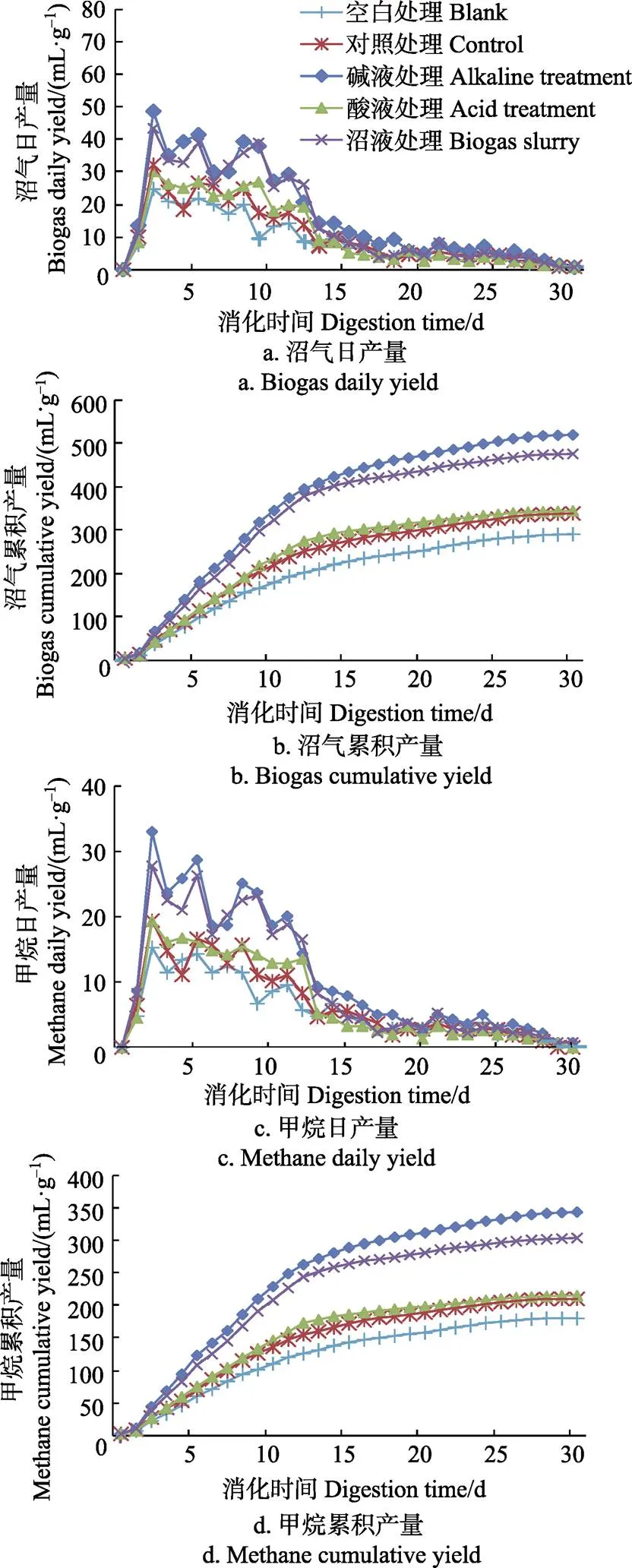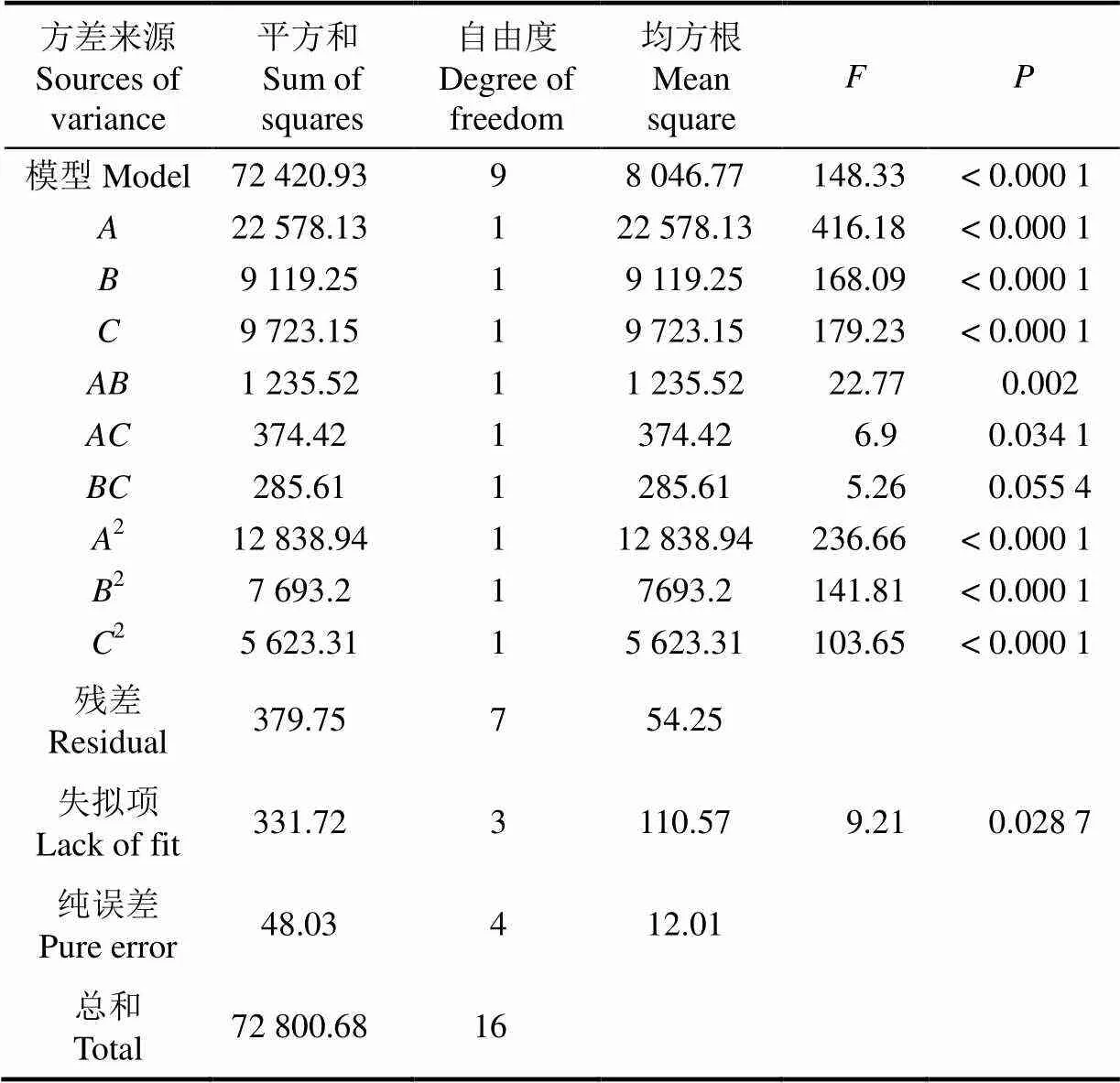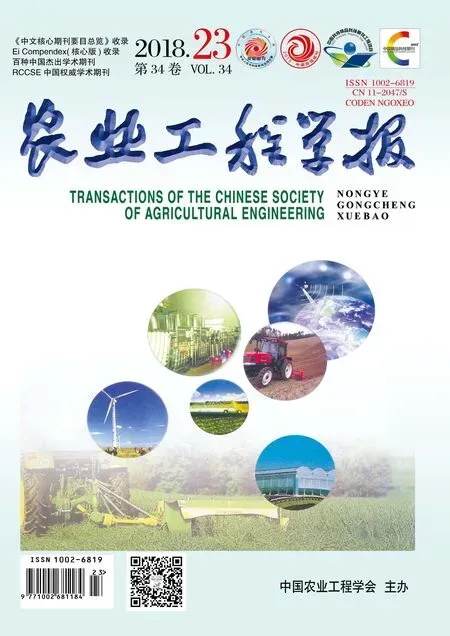玉米秸秆厌氧消化预处理方法及工艺优化
王旭辉,徐 鑫,山其米克,王 卉,叶 凯,李 冠,邓 宇
玉米秸秆厌氧消化预处理方法及工艺优化
王旭辉1,2,徐 鑫3,山其米克2,王 卉2,叶 凯2,李 冠1※,邓 宇4
(1. 新疆大学生命科学与技术学院,乌鲁木齐 830046;2. 新疆农业科学院生物质能源研究所,乌鲁木齐 830091; 3. 新疆农业科学院粮食作物研究所,乌鲁木齐 830091;4. 农业部沼气科学研究所,成都 610041)
为提高玉米秸秆厌氧消化性能,该文采用碱液、酸液、沼液等方法对玉米秸秆进行预处理,比较不同预处理方式对秸秆成分、含量以及厌氧消化能力的影响。试验结果表明,经超声波辅助碱预处理后,秸秆的木质素和半纤维素总含量显著降低,产气量显著提高。基于Box-Behnken(BBK)试验设计,选择碱液预处理的固固比(NaOH/秸秆,下同)、预处理温度、预处理时间为试验因素,结合响应面分析法对碱液预处理条件进行响应面优化,结果表明,最佳玉米秸秆预处理条件为固固比22.4%,预处理温度37.9 ℃,预处理时间39.7 h,在此条件下还原糖产量的试验值为738.6 mg/g,沼气累积产量的试验值为661mL/g,试验值与预测值误差不到0.5%,证明了响应面优化法的准确性和可行性。
纤维素;秸秆;沼气;预处理;响应面法
0 引 言
木质纤维素是一种含量丰富的可再生能源,并广泛存在于农作物秸秆中。木质纤维素主要由纤维素、半纤维素和木质素等组成,纤维素被半纤维素与木质素包裹,在环境中结构十分稳定,在自然环境中很难被降解[1-4]。因为木质纤维素具有高度的结晶性和聚合度,如果直接利用秸秆进行沼气厌氧发酵,会出现启动慢、时间长、转化利用率低等问题[5]。因此在沼气发酵前必须对秸秆原料进行预处理,破坏纤维素的结晶性并降低聚合度,脱出木质素和半纤维素的包覆作用,提高纤维素的水解率和沼气产气量,对秸秆等农业废弃物资源化利用具有重要意义。
国内外常见的秸秆预处理方法主要包括物理法、化学法和生物法[6]。物理方法有机械研磨、蒸汽爆破[7]、微波处理[8]、膨化处理[9]、超声波处理[10]等,其目的主要是破坏秸秆结晶性,增加微生物与基质的接触面积,使处理后的秸秆更易于消化,物理方法操作简单,处理时间短。Lukas等[11]用热膨胀法预处理秸秆,在温度170 ℃和时间20 min时,沼气产气量最大增长41%。一些研究学者在蒸汽爆破法预处理秸秆过程中添加强碱、强酸或氨水等作为爆破预处理强化剂,可以大大提高预处理后秸秆沼气产量[12-16]。化学方法主要有氨化[17-18]、碱化[19]、酸化[20-21]等,可改变秸秆的结构、成分和物理性质,处理效率比较高。Deepa等[22]用低浓度NaOH处理秸秆3 h,与未经NaOH处理秸秆相比,甲烷产气量提高了34%。Song等[23]用3%的双氧水预处理小麦秸秆之后甲烷产气量远高于未经预处理的甲烷产气量。生物方法[24-28]是利用具有强纤维素降解能力的微生物对秸秆进行生物降解,具有处理条件温和、没有环境污染等优点。来航线等[29]筛选得到2株优良高水解性能菌株Z026和Z027,并将其制备成秸秆沼气发酵菌剂。结果表明,自制菌剂具有优良发酵性能,对秸秆沼气发酵有明显促进作用。
本研究以玉米秸秆为对象,对比研究了超声波辅助稀碱、稀酸、沼液3种不同预处理方式对秸秆成分、还原糖产量、总产气量、甲烷产气量等方面的影响,对最佳的预处理方法展开单因素和响应面优化试验研究,通过响应面法优化得到玉米秸秆预处理最优工艺,为新疆地区玉米秸秆的沼气发酵的预处理提供科学依据。
1 材料与方法
1.1 试验原材料与试剂
玉米秸秆来自新疆农业科学院生物质能源研究所玛纳斯试验基地,风干、粉碎至粒径≤4 mm。其含水率为8.0%,纤维素质量分数为39.8%,半纤维素质量分数为20.7%,木质素质量分数为23.9%,灰分为5.9%。无水亚硫酸钠、苯酚、浓硫酸、3,5-二硝基水杨酸、酒石酸钾钠、NaOH等均为分析纯,购自国药集团。菌剂为自制秸秆专用微生物菌剂,菌剂含有蜡样芽孢杆菌、枯草芽孢杆菌、松嫩假单胞菌(质量比3∶2∶2)。赫奇逊氏无机盐培养基:KH2PO41.0 g,NaCl 0.1 g,NaNO32.5 g,CaCl20.1 g,MgSO4·7H2O 0.3 g,加去离子水至 1 L,pH值7.2。
1.2 主要试验仪器和试验装置
台式数控超声波清洗器(AS10200A,天津奥特赛恩斯仪器有限公司);甲烷检测仪(SK-800-CH4,深圳市东日瀛能);电热恒温鼓风干燥箱(DHG-9146A,上海精宏实验设备有限公司);紫外可见分光光度计(UVmini-1240,日本岛津公司);气相色谱仪(6890N GC,美国安捷伦公司)。
1.3 分析方法
还原糖含量采用 DNS 法测定;水分测定采用105 ℃恒质量法[30];秸秆失质量率、纤维素含量、半纤维素含量、木质素含量采用范氏法测定[31-32];沼气中CH4由气相色谱来分析,设备配置为热导检测器,载气为氮气,流量设为30 mL/mm,进样口、柱箱和检测器温度分别为120、100 和120 ℃。超声波预处理的频率40 kHz,功率30 W。
1.4 试验设计
1.4.1 不同秸秆预处理效果比较
以下各处理的试验参数通过预试验确定,控制整个预处理过程液体量为150 mL。
1)空白处理。称取粉碎后的玉米秸秆粉25 g加入500 mL预处理罐中,加入150 mL的蒸馏水放入水浴锅中,温度为35 ℃,预处理48 h。
2)对照处理。称取粉碎后的玉米秸秆粉25 g加入500 mL预处理罐中,加入150 mL的蒸馏水放入超声波仪中,功率30 W超声30 min,放入水浴锅中,温度为35 ℃,预处理48 h。
3)碱液处理。称取粉碎后的玉米秸秆粉25 g加入500 mL预处理罐中,加入150 mL的蒸馏水放入超声波仪中,超声30 min,加入5 g NaOH,放入水浴锅进行碱预处理,温度为35 ℃,预处理48 h。
4)酸液处理。称取粉碎后的玉米秸秆粉25 g加入500 mL预处理罐中,加入148 mL的蒸馏水放入超声波仪中,超声30 min,加入2 mL浓硫酸分析纯,置于超声波仪中30 min,放入水浴锅进行酸预处理,温度为35 ℃,预处理48 h。
5)沼液处理。称取粉碎后的玉米秸秆粉25 g加入500 mL预处理罐中,加入145 mL的蒸馏水放入超声波仪中,超声30 min,加入5 mL玉米秸秆沼液,放入水浴锅进行沼液预处理,温度为35 ℃,预处理48 h。
溶液预处理后离心,并用蒸馏水将滤渣洗至中性,于50 ℃烘干至恒质量,得预处理玉米秸秆样品。预处理后样品进行蒸馏水冲洗,从冲洗后固体称取三分之一的样品,并分析失质量率和化学成分(纤维素,半纤维素和木质素)。另外的三分之一预处理固体加入到三角瓶中,加入150 mL赫奇逊氏无机盐培养液,微生物菌剂添加量为预处理固体的十分之一,水解条件为150 r/min,30 ℃,72 h后分别测定总还原糖产量。剩余的三分之一的固体用作厌氧消化,分别将不同处理后的秸秆与50%(污泥干物质质量占处理后秸秆干物质质量的百分比,下同)的接种污泥混合均匀。将原料置于消化瓶中,厌氧消化30 d,每天上午10点记录沼气产量和甲烷产量。每个处理重复3次,选择预处理效果最好的处理方法进行后续单因素和响应面优化试验。
1.4.2 单因素试验设计
以超声波辅助碱处理时的固固比、预处理温度、预处理时间为试验因素。称取粉碎后的玉米秸秆粉50 g加入500 mL预处理罐中,加入150 mL的蒸馏水放入超声波仪中。置于超声波仪中超声30 min,然后放入水浴锅进行碱预处理。
分别研究固固比、反应时间、反应温度对还原糖和沼气产量的影响。固固比取12%,16%,20%,24%,28%,预处理温度为30 ℃,预处理时间30 h;预处理温度为25、30、35、40和45 ℃时,预处理时间为30 h,固固比20%;预处理时间为24、30、36、42和48 h,固固比20%,预处理温度35℃。作为比较,添加同样质量秸秆和与150 mL水混合作为空白对照进行培养和评估。
准确称取5 g蒸馏水冲洗后的预处理样品分别进行还原糖产量测定和沼气产量测定,测定方法同1.4.1。
1.4.3 响应面法优化分析
以BBK的中心组合试验设计为基础,结合单因素试验的结果设计三因素三水平的响应面分析法,分别选取固固比、预处理温度、预处理时间作为自变量,以总还原糖产量,总沼气产气量作为响应值设计响应面试验,因素和水平编码见表1。

表1 响应面法的编码水平和因素
2 结果分析
2.1 不同秸秆预处理效果比较
秸秆质量的变化和纤维素含量的变化可以直接反映整个厌氧发酵过程中秸秆结构的破坏及降解程度,预处理前后玉米秸秆主要成分变化见表2。预处理后固体的失质量率在4.5%~5.6%之间,对照组的失质量率最低,酸液处理的失质量率最高。酸液处理不但对木质素、半纤维素有降解作用,对纤维素也有很强的降解作用,而碱液处理只对木质素和半纤维有降解作用,碱液处理的秸秆纤维素含量和还原糖产量大大高于酸液处理和沼液处理,对照组由于水溶液对木质素结构破坏很小,虽然纤维素含量变化不大,但由于其被木质素包裹很难转化为还原糖。

表2 预处理前后玉米秸秆主要成分变化
厌氧消化结果可以用以分析不同预处理的秸秆产沼气能力,整个厌氧消化周期为30 d,其沼气日产量、沼气累积产量、甲烷日产量及甲烷累积产量分别见图1。沼气日产量和甲烷日产量规律基本一致,均在2 d之内开始产沼气和甲烷,并在整个产气周期内出现4个产气高峰。空白组的产气率最低,碱液预处理秸秆表现出较高的产沼气及产甲烷率,最高沼气产量和甲烷产量分别达到了49、33 mL/g。
由沼气累积产量及甲烷累积产量图中可以看出,沼气累积产量和甲烷累积产量均在前15 d快速上升,并达到最终产气量的85%~90%。碱液预处理秸秆获得最高的累积产沼气及产甲烷率,最高沼气累积产量和甲烷累积产量分别达到了518、342 mL/g,而未预处理的秸秆沼气累积产量和甲烷累积产量分别为288和178 mL/g。产气量和纤维素含量成正比例关联,纤维素含量越大其产沼气量、产甲烷量也越高,所以选择产气量最高的碱液预处理进行后续的单因素和响应面优化试验。
2.2 单因素试验结果
2.2.1 不同固固比预处理秸秆对还原糖产量和沼气累积产量的影响
不同固固比预处理后秸秆酶水解产生还原糖的产量变化见图2。由图2可知,NaOH预处理对水解速率有明显的提高作用,随着固固比值升高,还原糖产量逐渐升高,固固比在20%时获得最高的还原糖产量556.4 mg/g,而24%和28%固固比的还原糖产量与20%比值下基本相同。随着固固比值由12%提高到20%,沼气总产量也逐渐提高,20%固固比值下达到499 mL/g。当固固比值大于20%后,24%和28%浓度的沼气总产量没有显著提升。提高预处理固固比值会增大经济成本,同时造成预处理中固体损失率的加大,所以选取20%固固比值为最优值。

图1 不同预处理玉米秸秆的沼气及甲烷产量

注:温度30℃,时间30 h。
2.2.2 不同温度预处理秸秆对还原糖产量和沼气累积产量的影响
不同温度条件预处理后秸秆酶水解产生还原糖的产量变化见图3。由图3可知,预处理温度对还原糖产量有明显的提高作用,随着温度升高,还原糖产量逐渐升高,35 ℃获得最高的还原糖产量615.5 mg/g,而预处理温度40 和45 还原糖产量与35 ℃下基本相同。随着温度由25 提高到35 ℃,总沼气产量也逐渐提高,35 ℃下达到544 mL/g。当温度大于35后,40 和45 ℃的总沼气产量没有显著提升。提高温度会增大经济的投入,同时造成预处理中固体损失率的加大,所以选择35 ℃条件为最优值。

注:固固比20%,时间30 h。
2.2.3 不同时间预处理秸秆对还原糖产量和沼气累积产量的影响
不同时间条件预处理后秸秆酶水解产生还原糖的产量变化见图4。由图4可知预处理时间对水解速率有明显的提高作用,随着时间增加,还原糖产量逐渐升高,36 h获得最高的还原糖产量693.2 mg/g,而预处理42和48还原糖产量与36 h变化不大。不同预处理时间后沼气累积产气量见图4,然后随着预处理时间由24 h提高到36 h,总沼气产量也逐渐提高,36 h条件下分别达到613 mL/g。当时间大于36 h后,42和48 h的总沼气产量没有显著提升。提高预处理时间增大经济的投入量,同时造成预处理中固体损失率的加大,所以选取36 h为最优值。

注:温度35 ℃,固固比20%。
2.3 响应面优化试验
2.3.1 响应面法试验设计及结果
利用Box-Behnken Design(BBD)的中心组合原理设计响应面优化试验,以固固比、预处理温度、预处理时间为因素,以预处理秸秆还原糖产量和沼气累积产量为响应值,设计三因素三水平的响应面分析试验。响应面法试验设计与试验结果如表3所示,在17组试验预测数据中,还原糖产量最低为533.8 mg/g,还原糖产量最高为708.6 mg/g,沼气累积产量最低为488 mL/g,沼气累积产量最高为641 mL/g,再用Design-Expert 8.0.5.0软件对表3试验结果进行多元拟合的回归分析。

表3 响应面设计与试验结果
2.3.2 响应面法优化结果分析
采用Design-Expert 8.0.5.0软件对所得数据进行多元回归拟合,其还原糖产量方差分析结果见表4。对响应值与各个因素进行多元拟合,该模型对应的回归方程(1)为
还原糖产量=702.54+53.13´+33.76´+34.86´+
17.57´´+9.68´´+8.45´´-55.22´2-
42.75´2-36.54´2(1)
为了检验方程的准确性,对还原糖产量的数学模型进行方差分析,结果见表4。由表4可知,还原糖产量的显著性检验=148.33,该模型效应极显著(<0.01),表明方程高度显著。该模型的该模型的失拟项值为0.002 87,调节2为0.988 1,说明模型能反映98.81%响应值的变化,因而该模型拟合程度较高,能很好的说明还原糖产量与固固比、预处理温度、预处理时间的关系,因此可以用此模型对还原糖产量进行预测与分析。表4各因素之间存在交互作用,其中一次项、、以及交互项都是极显著的。
采用Design-Expert 8.0.5.0软件对所得数据进行多元回归拟合,其还沼气累积产量方差分析结果见表5。对响应值与各个因素进行多元拟合,该模型对应的回归方程(2)为
沼气累积产量=633.20+43.13´+31.00´+30.88´+
13.00´´+6.75´´+6.50´´-46.23´2-
38.48´2-31.72´2(2)
为了检验方程的准确性,对沼气累积产量的数学模型进行方差分析,结果见表5。由表5可知,沼气累积产量的显著性检验=78.07,该模型效应极显著(<0.01),表明方程高度显著。该模型的失拟项值为0.005 5,调节2为0.977 5,说明模型能反映97.75%响应值的变化,因而该模型拟合程度较高,能很好的说明沼气累积产量与固固比、预处理温度、预处理时间的关系,因此可以用此模型对沼气累积产量进行预测与分析。表5各因素之间存在交互作用,其中一次项、、以及交互项都是极显著的。

表4 还原糖产量回归模型的方差分析
2.3.3 响应面及等高线分析
交互项、、都是极显著作用。在图5中,交互项、、交互关系用响应面曲面图表示,响应曲面图均为开口向下的凸形曲面,说明响应值(还原糖产量和沼气累积产量)存在极高值,若曲线越陡峭,则表明该2因素交互作用对还原糖产量和沼气累积产量的影响越大,相应表现为响应值变化的大小。

表5 沼气累积产量回归模型的方差分析
回归方程进行回归分析,得到响应面优化的最佳条件:当固固比、预处理温度、预处理时间分别为22.4%,37.9 ℃,39.7 h,在此条件下还原糖产量的预测值为740.1 mg/g,沼气累积产量的预测值为663.8 mL/g,还原糖产量的试验值为738.6 mg/g,沼气累积产量的试验值为661 mL/g,试验值与预测值误差不到0.5%,证明了响应面优化法的准确性和可行性。

图5 交互因素对还原糖产量和沼气累计产量的响应曲面图
3 讨 论
1)与其他预处理方式相比,超声波辅助碱预处理在提高秸秆物能转化率、缩短发酵时间、增加产气率及降低成本方面均有优势。秸秆沼气工程预处理方式的选择不仅需要考虑产气率的提升,也应考虑沼液后续处理的问题。碱性溶液可以中和厌氧发酵过程中产生各种酸性产物,也可以防止后续酸化过程中pH值的下降,碱液预处理是预防发酵液酸化的优良添加剂。碱液预处理是今后玉米秸秆沼气发酵工程较为的理想方法。
2)本文通过碱法预处理的工艺条件,使得玉米秸秆的沼气发酵效率得到了改进,但是没有深入分析碱液预处理过程对秸秆结构的影响,预处理后秸秆损耗也很多,因此通过SEM扫描电镜、X射线衍射等方法,分析秸秆降解过程的机理,对秸秆降解进行选择性调控,进一步抑制秸秆的损耗是下一步应该进行深入研究的重点。
4 结 论
1)碱液处理组的木质素降解率和半纤维素降解率远高于酸液、沼液处理组,而且失质量率比较低,很好的保留了纤维素成分,沼气产量和甲烷产量是所有处理组中最高的。
2)响应面方法具有实验精度高、实验次数少和周期短等优点,可准确快速地计算多因素系统的最优条件。本试验基于BBD试验设计原理,结合单因素试验的结果设计三因素三水平的响应面分析法,利用响应面分析法建立了以总沼气产气量和还原总糖产量为响应值的数学模型,并在此基础上进行了发酵工艺的模拟优化。对回归方程进行回归分析,得出响应面优化的最佳条件:固固比、预处理温度、预处理时间分别为22.4%,37.9℃,39.7 h,在此条件下还原糖产量的预测值为740.1 mg/g,沼气累积产量的预测值为663.8 mL/g,还原糖产量的试验值为738.6 mg/g,沼气累积产量的试验值为661 mL/g,试验值与预测值误差不到0.5%,证明了响应面优化法的准确性和可行性。
[1] Angela C R, Marcela B, Natalia S S, et al. Treatment of paper pulp and paper mill wastewater by coagulation-flocculation followed by heterogeneous photocatalysis[J]. Journal of Photochemistry and Photobiology A: Chemistry, 2008, 194(1): 1-10.
[2] Georgakakis D, Krintas T. Optimal use of the Hosoya system in composting poultry manure[J]. Bioresource Technology, 2000, 72(1): 227-233.
[3] 陈子爱,邓小晨.微生物处理利用秸杆的研究进展[J].中国沼气,2006,24(3):31-35. Chen Ziai, Deng Xiaochen. Progress in microbiologic utilization of crop straw[J]. China biogas, 2006, 24(3): 31-35. (in Chinese with English abstract)
[4] 李平,王焰新,刘琨,等.高效纤维素降解菌系的构建[J].地球科学(中国地质大学学报),2009,34(3):533-538. Li Ping, Wang Yanxin, Liu Kun, et al. Construction of a microbial system or efficient degradation of cellulose[J]. Earth Science (Journel of China University of Geoscience), 2009, 34 (3): 533-538. (in Chinese with English abstract)
[5] 覃国栋,刘荣厚,孙辰.NaOH 预处理对水稻秸秆沼气发酵的影响[J].农业工程学报,2011,27(增刊1): 59-63. Qin Guodong, Liu Ronghou, Sun Chen. Effects of different concentrations of NaOH pretreatment on anaerobic digestion of rice straw for biogas production[J]. Transactions of the Chinese Society of Agricultural Engineering (Transactions of the CSAE), 2011, 27(Supp. l): 59-63. (in Chinese with English abstract)
[6] 李淑兰,梅自力,张国治,等.秸秆厌氧消化预处理技术综述[J].中国沼气,2011,29(5):29-33.Li Shulan, Mei Zili, Zhang Guozhi, et al. Review of pretreatment technology for crop straw anaerobic digestion[J]. China Biogas, 2011, 29(5): 29-33. (in Chinese with English abstract)
[7] 李刚,李东亮,王许涛,等.玉米秸秆蒸汽爆破用于厌氧发酵的技术评价[J].农业工程学报,2011,27(1):286-290. Li Gang, Li Dongliang, Wang Xutao, et al. Technology evaluation of steam exploded corn stalk anaerobic fermentation[J]. Transactions of the Chinese Society of Agricultural Engineering (Transactions of the CSAE), 2011, 27(1): 286-290. (in Chinese with English abstract)
[8] 冯磊,李润东,Bernhard Raninger,等.微波预处理对秸秆厌氧消化影响的研究[J].环境工程学报,2009,3(8):1503-1508. Feng Lei, Li Rundong, Bernhard Raninger, et al. Efficiency of anaerobic digestion of straw pretreated with microwave energy[J]. Chinese Journal of Environmental Engineering, 2009, 3(8): 1503-1508. (in Chinese with English abstract)
[9] 寇巍,赵勇,闫昌国,等.膨化预处理玉米秸秆提高还原糖酶解产量的效果[J].农业工程学报,2010,26(11):265-269. Kou Wei, Zhao Yong, Yan Changguo, et al. Corn straw expansion pretreatment to improve enzymolysis reducing sugar yield[J]. Transactions of the Chinese Society of Agricultural Engineering (Transactions of the CSAE), 2010, 26(11): 265-269. (in Chinese with English abstract)
[10] 胡斌,张亮亮,胡青平.超声波预处理玉米秸秆的条件优化[J].西北农业学报,2012,21(2):153-156. Hu Bin, Zhang Liangliang, Hu Qingping. Optimization of ultrasonic pretreatment for corn straw[J]. Acta Agriculturae Boreali-occidentalis Sinica. 2012, 21(2): 153-156. (in Chinese with English abstract)
[11] Lukas, Tomas. The effect of process parameters during the thermal-expansionary pretreatment of wheat straw on hydrolysate quality and on biogas yield[J]. Renewable Energy. 2015, 77: 250-258.
[12] 黄仁亮,刘锐,苏荣欣,等.玉米芯氨水预处理及酶解工艺研究[J].化学工程,2009,37(9):40-43.Huang Renliang, Liu Rui, Su Rongxin, et al. Aqueous ammonia pretreatment and enzymatic hydrolysis of corn cobs[J]. Chemical Engineering(China), 2009, 37(9): 40-43. (in Chinese with English abstract)
[13] Viola E, Zimbardi F, Cardinale M, et al. Processing cereal straws by steam explosion in a pilot plant to enhance digestibility in ruminants[J]. Bioresource Technology, 2008, 99(4): 681-689.
[14] Carrasco J E, Ma C S, Navarro A, et al. Effects of dilute acid and steam explosion pretreatments on the cellulose structure and kinetics of cellulosic fraction hydrolysis by dilute acids in lignocellulosic materials[J]. Applied Biochemistry and Biotechnology, 1994, 45/46(1): 23-34.
[15] Tucker M P, Kim K H, Newman M M, et al. Effects of temperature and moisture on dilute-acid steam explosion pretreatment of corn stover and cellulase enzyme digestibility[J]. Applied Biochemistry and Biotechnology, 2003, 105(1/2/3): 165-177.
[16] 靳胜英,张福琴,张礼安.木质纤维原料制乙醇原料预处理技术[J].中国工程科学,2008,10(11):82-88.Jin Shengying, Zhang Fuqin, Zhang Li’an. Pretreatment method of lignocellulosic materials for bioethanol production[J]. Engineering Sciences, 2008, 10(11): 82-88. (in Chinese with English abstract)
[17] 马兴元,刘琪,马君.氨化预处理对生物质秸秆厌氧发酵的影响[J].生态环境学报,2011,20(10):1503-1506.Ma Xingyuan, Liu Qi, Ma Jun. The effects of ammoniation pretreatment on anaerobic fermentation of the Biomass straw[J]. Ecology and Environmental Sciences, 2011, 20(10): 1503-1506. (in Chinese with English abstract)
[18] 马淑勍,袁海荣,朱保宁,等.氨化预处理对稻草厌氧消化产气性能影响[J].农业工程学报,2011,27(6):294-299.Ma Shuqing, Yuan Hairong, Zhu Baoning, et al. Effects of ammoniation pretreatment on anaerobic digestion performance of rice straw[J]. Transactions of the Chinese Society of Agricultural Engineering (Transactions of the CSAE), 2011, 27(6): 294-299. (in Chinese with English abstract)
[19] 刘研萍,方刚,党锋,等.NaOH和H2O2预处理对玉米秸秆厌氧消化的影响[J].农业工程学报,2011,27(12):260-263.Liu Yanping, Fang Gang, Dang Feng, et al. Effect of NaOH and H2O2pretreatment on corn straw anaerobic digestion[J]. Transactions of the Chinese Society of Agricultural Engineering (Transactions of the CSAE), 2011, 27(12): 260-263. (in Chinese with English abstract)
[20] 覃国栋,刘荣厚,孙辰.酸预处理对水稻秸秆沼气发酵的影响[J].上海交通大学学报:农业科学版,2011,29(1):58-61.Qin Guodong, Liu Ronghou, Sun Chen. Effects of acid pretreatment on biogas fermentation of rice straw[J]. Journal of Shanhai Jiaotong University: Agricultural Science, 2011, 29(1): 58-61. (in Chinese with English abstract)
[21] 徐龙君,安丽娜,农丽薇,等.稀盐酸预处理对稻草厌氧消化的影响[J].环境工程学报,2011,5(3):671-674.Xu Longjun, An Lina, Nong Liwei, et al. Effect of pretreatment of dilute hydrochloric acid on anaerobic digestion of rice straw[J]. Chinese Journal of Environmental Engineering, 2011, 5(3): 671-674. (in Chinese with English abstract)
[22] Deepa J S, Pranav K, Sneha T M, et al. Alkali pretreatment at ambient temperature: A promising method to enhance biomethanation of rice straw[J]. Bioresource Technology. 2017, 226(2): 80-88.
[23] Song Zilin, Zhang Chao. Anaerobic codigestion of pretreated wheat straw with cattle manure and analysis of the microbial community[J]. Bioresource Technology. 2015,186(6): 128-135.
[24] 闫志英,袁月祥,刘晓风,等.复合菌剂预处理秸秆产沼气[J].四川农业大学学报,2009,27(2):176-179.Yan Zhiying, Yuan Yuexiang , Liu Xiaofeng , et al. A study on biogas fermentation with straws[J]. Journal of Sichuan Agricultural University, 2009, 27(2): 176-179. (in Chinese with English abstract)
[25] 袁旭峰,高瑞芳,李培培,等.复合菌系MC1预处理对玉米秸秆厌氧发酵产甲烷效率的提高[J].农业工程学报,2011,27(9):266-270.Yuan Xufeng, Gao Ruifang, Li Peipei, et al. Improvement of anaerobic biogasification efficiency by pretreatment of corn straw with composite microbial system of MC1[J]. Transactions of the Chinese Society of Agricultural Engineering (Transactions of the CSAE), 2011, 27(9): 266-270. (in Chinese with English abstract)
[26] 石卫国.生物复合菌剂处理秸秆产沼气研究[J].农业工程学报,2006,22(增刊 1):93-95.Shi Weiguo. Research on producing biogas through treating straw with microbes[J]. Transactions of the Chinese Society of Agricultural Engineering (Transactions of the CSAE), 2006, 22(Supp. 1): 93-95. (in Chinese with English abstract)
[27] 刘德江,邱桃玉,饶晓娟,等.小麦、玉米秸秆不同预处理产沼气试验研究[J].中国沼气,2012,30(3):34-37.Liu Dejiang, Qiu Taoyu, Rao Xiaojuan, et al. Biogas production of wheat and corn straw with different pretreatment[J]. China Biogas, 2012, 30(3): 34-37. (in Chinese with English abstract)
[28] 李秀金.山东省德州市秸秆沼气集中供气示范工程运行模式与管理经验[J].农业工程技术:新能源产业,2010(4):6-9.Li Xiujin. Operation model and management experience of centralized biogas demonstration projects from crop straws in Dezhou City, Shandong Province[J]. Agricultural Engineering Technology, 2010(4): 6-9. (in Chinese with English abstract)
[29] 来航线,杨兴华,焦延雄,等.菌剂预处理原料对沼气发酵效果的影响[J].西北农业学报,2011,20(6):199-202.Lai Hangxian, Yang Xinghua, Jiao Yanxiong, et al. Effect of raw materials pretreated by microbial inoculum on biogas fermentation[J]. Acta Agriculturae Boreali-occidentalis Sinica. 2011, 20(6): 199-202. (in Chinese with English abstract)
[30] 朱懿德.工业发酵分析[M].北京:中国轻工业出版社,1997.
[31] 王玉万.木质纤维素固体基质发酵物中半纤维素、纤维素和木质素的定量分析程序[J]. 微生物学通报,1987,14(2): 81-84.Wang Yuwan. Quantitative analysis procedures for hemicellulose, cellulose and lignin in lignocellulosic solid substrate ferment[J]. Microbiology China. 1987, 14 (2): 35-38. (in Chinese with English abstract)
[32] 杨淑蕙.植物纤维化学[M].北京:中国轻工业出版社,2001.
Optimization of pretreatment process for corn straw anaerobic digest
Wang Xuhui1, 2, Xu Xin3, Shan Qimike2, Wang Hui2, Ye Kai2, Li guan1※, Deng Yu4
(1.830046,; 2.830091,; 3.830091,; 4.610041,
Lignocellulose is an abundant renewable energy source in crop straws. Lignocellulose is mainly composed of cellulose, hemicellulose, lignin and ash. The cellulose is not only encapsulated by lignin and hemicellulose, but also has a very stable structure and is not easily degraded in the natural environment. Lignocellulose has a high degree of crystallinity and polymerization, if the crop straw is directly used for biogas production, there are some problems such as slow start, low efficiency, and low conversion and utilization may occur. Therefore, straw raw materials must be pretreated to destroy the crystallinity of cellulose and reduce the degree of polymerization, remove the covering effect of lignin and hemicellulose, increase the hydrolysis rate of cellulose and the gas production of biogas before the biogas fermentation. In order to improve the anaerobic digestion performance of corn straw and reduce the treatment cost, this study used alkaline treatment, acid treatment and biogas slurry treatment to pretreat corn straw, and studied the effects of different pretreatment methods on cellulose content and anaerobic digestion rate. The results showed that the degradation rate of lignin and hemicellulose in alkaline treatment were much higher than that in the acid treatment and the biogas slurry treatment, and the weight loss rate was lower, and the cellulose composition was well preserved. Because of the biogas yield and methane yield were the highest in all treatment groups, the alkali treatment with the best pretreatment effect was selected for the subsequent process optimization experiment. Based on Box-Behnken Design (BBD) test design, the quality percentage of alkali treatment, pretreatment temperature and pretreatment time were selected as the test factors. Combined with the results of single factor test, the response surface analysis method of three factors and three levels was designed, and the response surface methodology was used to establish the process mathematical model with the response value of biogas cumulative yield and reducing sugar yield as the response value. The results showed that the optimum pretreatment conditions of corn straw were: the solid-solid ratio was 22.4%, the pretreatment temperature was 37.9 ℃, and the pretreatment time was 39.7 h. Under this condition, the experimental value of reducing sugar yield was 738.6 mg/g, and the cumulative biogas production value was 661 mL/g. The difference between the test value and the predicted value was less than 0.5%, which proved the accuracy and feasibility of the response surface optimization method.Compared with other pretreatment methods, alkali pretreatment had advantages in improving the conversion rate of straw, increasing the gas production rate and reducing the cost. The pretreatment of straw biogas project should not only consider the increase of gas production rate, but also the subsequent treatment of biogas slurry. The alkaline pretreatment could neutralize various acidic products during the anaerobic fermentation process, and could also prevent the decrease of pH value during subsequent acidification. Alkaline pretreatment was a good additive to prevent acidification of fermentation broth. Alkali pretreatment is an ideal method for biogas fermentation of corn straw in the future.
cellulose; straw; biogas; pretreatment; response surface methodology
王旭辉,徐 鑫,山其米克,王 卉,叶 凯,李 冠,邓 宇. 玉米秸秆厌氧消化预处理方法及工艺优化[J]. 农业工程学报,2018,34(23):246-253. doi:10.11975/j.issn.1002-6819.2018.23.032 http://www.tcsae.org
Wang Xuhui, Xu Xin, Shan Qimike, Wang Hui, Ye Kai, Li guan, Deng Yu. Optimization of pretreatment process for corn straw anaerobic digest[J]. Transactions of the Chinese Society of Agricultural Engineering (Transactions of the CSAE), 2018, 34(23): 246-253. (in Chinese with English abstract) doi:10.11975/j.issn.1002-6819.2018.23.032 http://www.tcsae.org
2018-07-27
2018-10-17
自治区科研机构创新发展专项资金项目(2016D04019);农业部农村可再生能源开发利用重点实验室开放基金(2017007);农业部农业生态与资源保护总站技术服务委托项目
王旭辉,助理研究员,博士生,主要从事生物质能源研究。E-mail:bio0407015@qq.com
李 冠,教授,博士生导师,主要从事植物生理生化与分子生物学研究。Email:guanli@xju.edu.cn
10.11975/j.issn.1002-6819.2018.23.032
S216.2
A
1002-6819(2018)-23-0246-08

